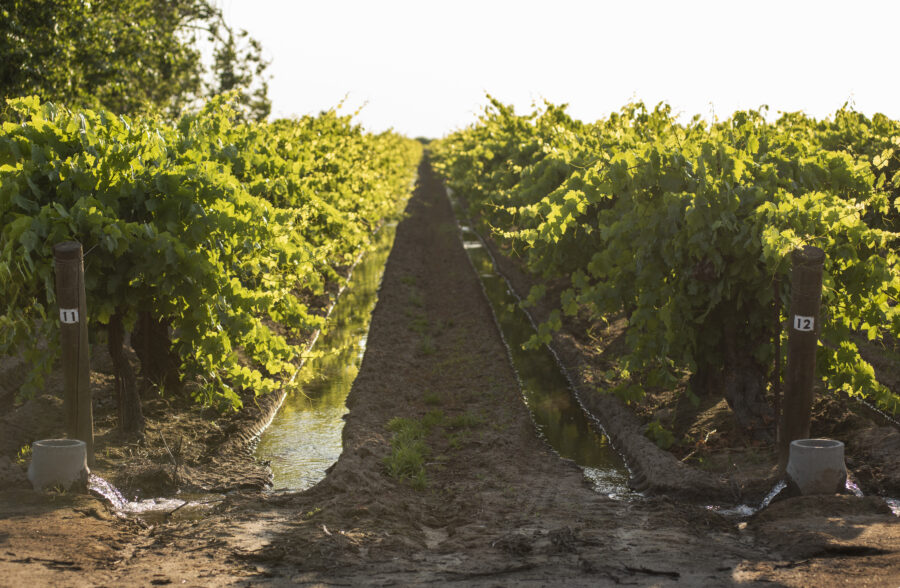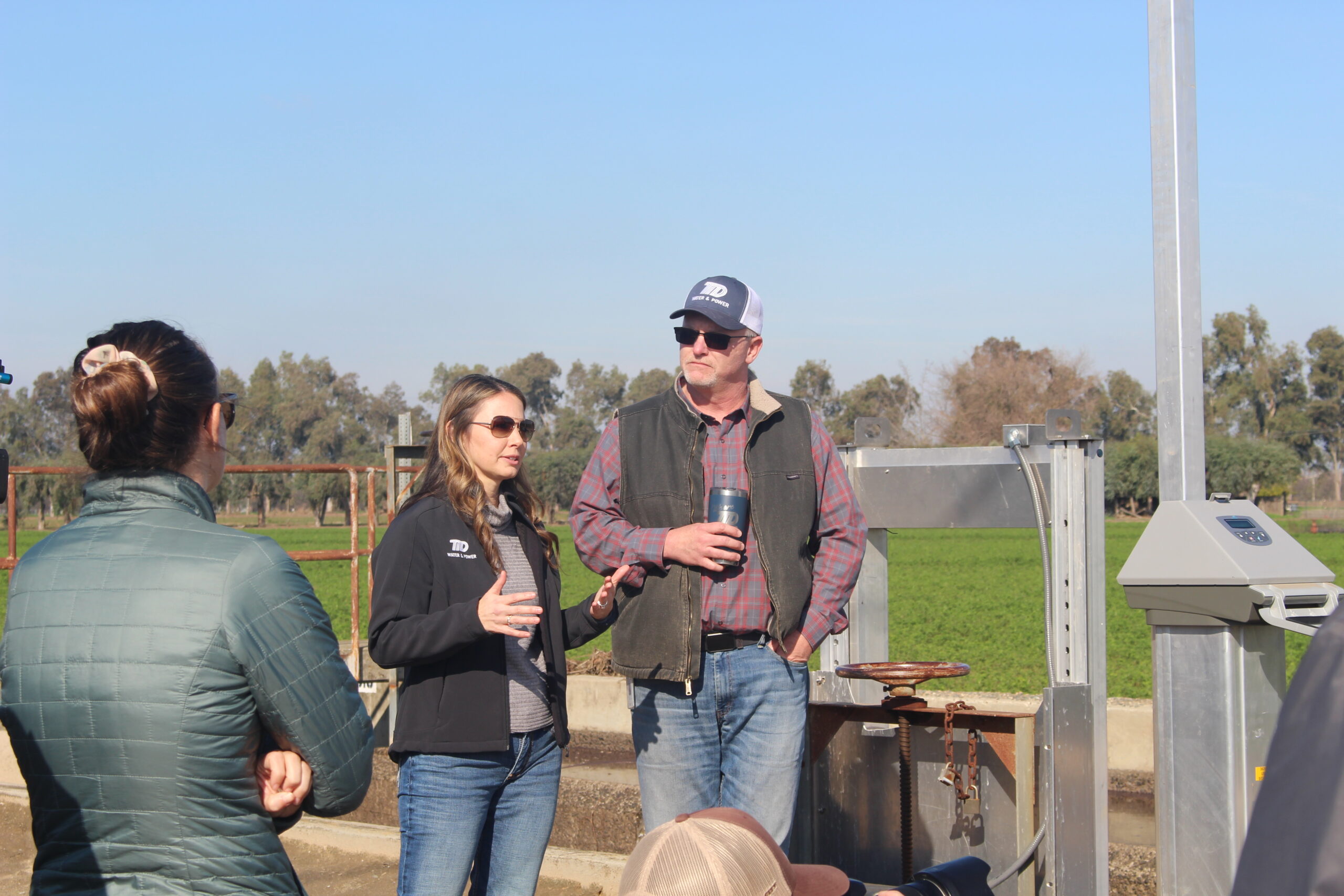
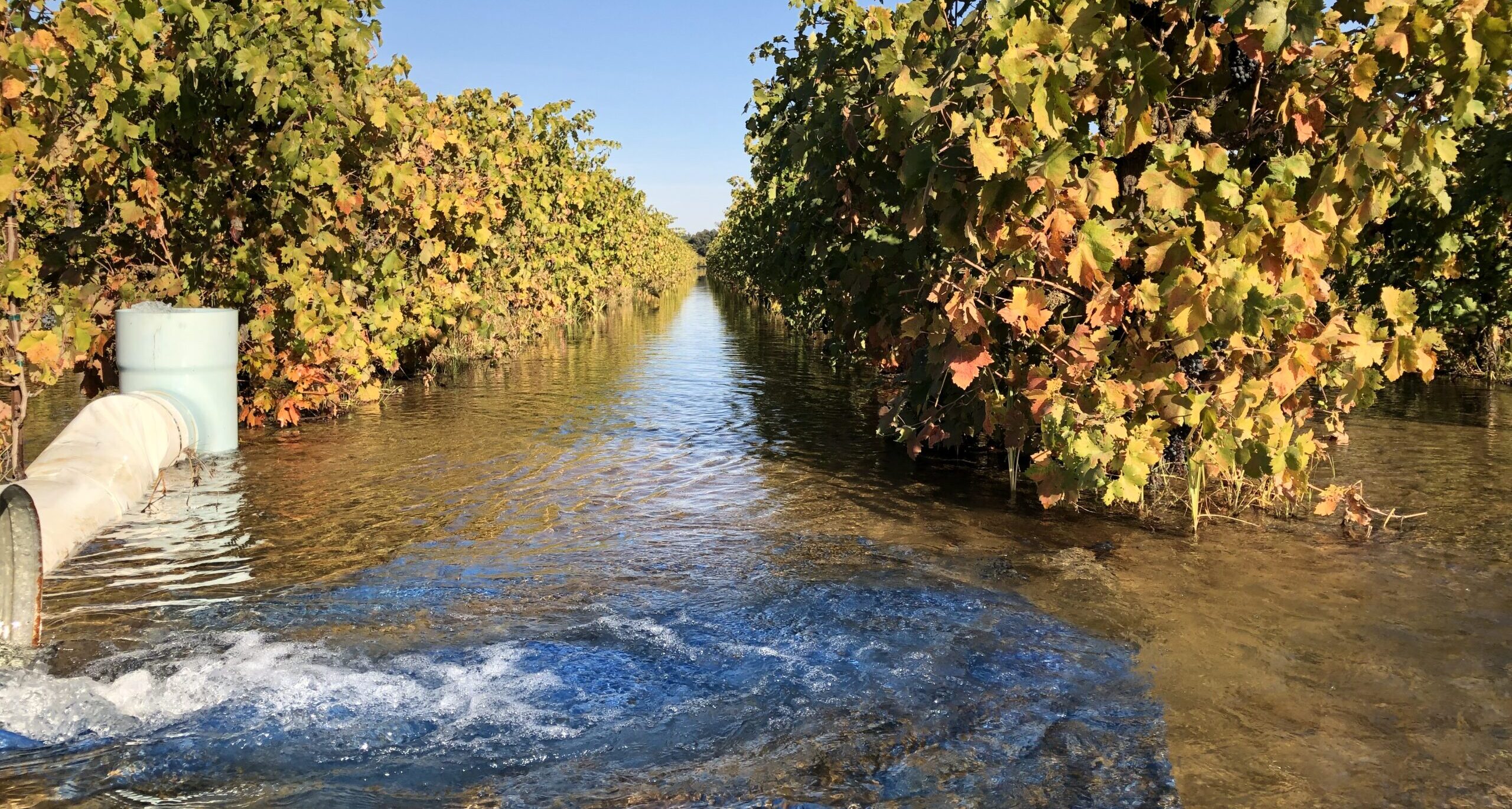
A Watershed Moment Interview Series
We’ll feature four conversations with groundwater recharge proponents across the state. Read our joint interview with TID’s Michelle Reimers and Wes Miller below!
Part of Something Bigger
Earlier this year, Sustainable Conservation sat down with Turlock Irrigation District’s (TID) General Manager Michelle Reimers and Supervising Engineering Technician Wes Miller to discuss water management in 2023. Thanks to careful planning and piloting, TID was able to act fast in our winter deluge to recharge as much water as they could with ready and willing growers like Christine and Erich Gemperle.
Reimers and Miller highlight their district’s evolving challenges while emphasizing the vital role of water for their local Turlock community. The interview underscores TID’s commitment to sustainable water use and contributing to the larger water supply solution, the integral role of agriculture in California’s water future, and the importance of clarifying permitting processes for effective water management.
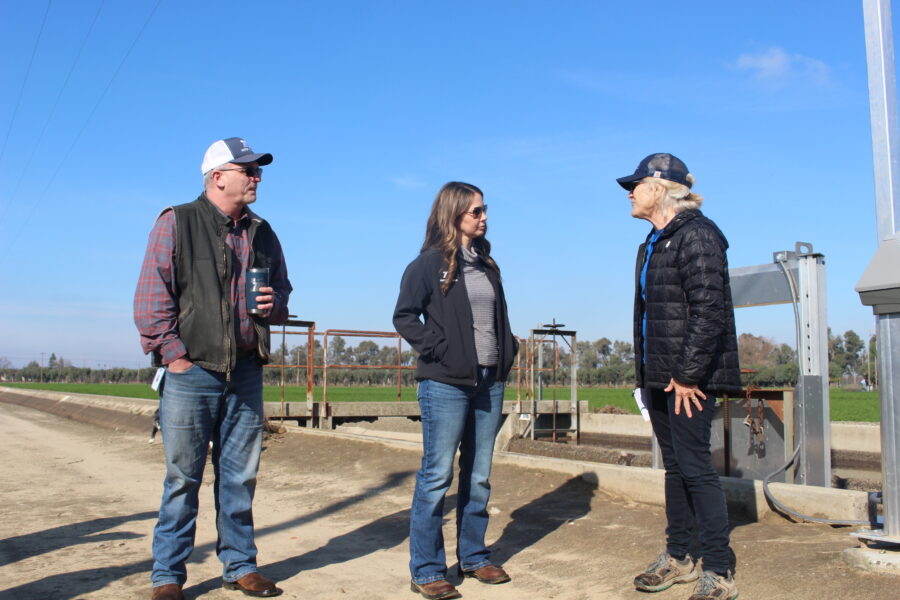
Wes Miller, Michelle Reimers, and Sustainable Conservation CEO Ashley Boren talking at a groundwater recharge field visit at Gemperle Orchards in Turlock
Sustainable Conservation: How did you both come to TID?
Wes Miller (WM): I was a farmer growing up. Our family had a specialty crop — what’s known as baby’s breath — and it was a popular specialty flower back in the day. I started at TID in ’95. I was in the warehouse as a mail runner and one of the Water Operations Managers at the time was Steve Boyd. He thought I would be a good fit for the job. I’ve been in this department in some shape or form for almost 27 years now, whether as an operator or as an operations manager or a project manager.
Michelle Reimers (MR): I was born and raised in the area as well. My grandparents had an almond orchard, so I was familiar with agriculture and its importance to the area. I graduated college with a communications degree. A public information officer job came up here at TID and I thought, “Well, that sounds kind of cool.” That was in 2006, so I’ve been here for 16 years. I worked my way up, similar to Wes, gradually taking on more responsibility. I started to oversee government affairs and communications and then programs, and now here I am.
Irrigated Land
Farms represent about 40% of California’s annual water usage. As a result, navigating the complex landscape of water management in California’s agricultural heartland is key to long-term water security.
What part do you think irrigated lands play in the larger California water future conversation?
MR: I think a solution for California water problems needs to be very comprehensive. It will include land fallowing as a form of conservation. It will look at how we can apply water without damaging crops on agricultural lands. Of course, there’s a lot of opportunity there, but you have to be able to store the water and get it to where it can be useful.
I feel like everybody talks about recharge like it’s the silver bullet, that it’s going to solve all the problems, and it won’t by itself. It takes a long time to see the benefits. If you can’t move the water around to the areas that need recharging with GRAT (Groundwater Recharge Assessment Tool) and others, your efficacy is limited. Not every soil is the same, not every groundwater basin is located at the same depth. Determining the areas where recharge can provide the greatest benefit should be done in a scientific way, to get the best bang for our buck in terms of recharge.
What’s something that an average urban water user who doesn’t necessarily know much about farming should understand about what you do, and what might be possible in California?
MR: Water use is about a return on investment. Farmers understand their product – what they grow, the value of it – and they don’t take water use lightly. I’m glad that you asked us about the challenges, and I’m glad we had the opportunity to show people. Growers can’t just open their gate and irrigate at any point. It’s not that simple.
WM: A lot of our farmers live where they farm. These are not thousand-acre operations. Our average parcel size is 28 acres. What they do with their water affects them and affects their domestic well. They drink the water that they’re using on their farm. It’s how they sustain their livelihood and the way their families have lived here for decades.
MR: They farm because they love what they do. Especially in our area, growing is rooted in them. This is what my dad did, what my grandpa did. Sometimes there are additional generations, and it’s a family legacy.
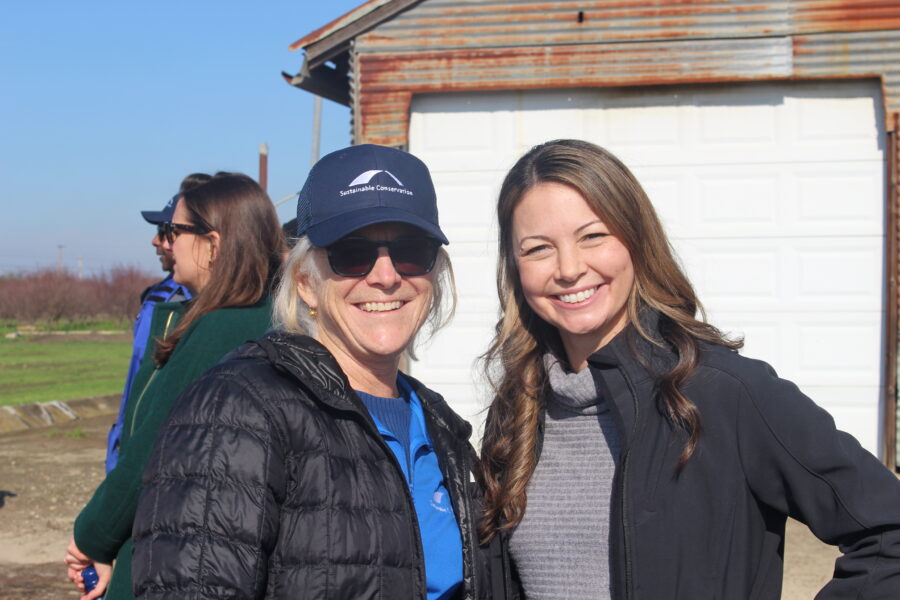
Ashley Boren and Michelle Reimers
Leveraging Groundwater
In recent years, groundwater recharge has emerged as a vital practice for sustainable water management. “Conjunctive use” water districts, where surface water and groundwater are simultaneously managed, can intentionally divert surface water during the wet season to let the excess water percolate down into the local aquifers. Recharge not only encourages sustainable groundwater use for agriculture and domestic use, but also brings about several multifaceted benefits to communities and the environment. Especially notably, as Wes and Michelle acknowledge, groundwater recharge can mitigate flood risks for downstream communities, a protection that will only grow in importance as the drought-deluge whiplash intensifies in California.
Tell us a bit about the history of groundwater recharge at TID. How did you develop your recharge program?
WM: TID has been a conjunctive use district for decades. We were predominantly flood irrigating heavily in the good water years, and we would turn to some groundwater in drier years. We have been doing some pilots and dedicated recharge basins on a small scale over the last 15-20 years in a couple different locations.
We did a very small pilot in 2019, but there wasn’t enough water to really have a meaningful pilot. This winter, our partnership with Sustainable Conservation and several of our farmers was one of the true first pilots where we’ve been able to put water in the ground and work with farmers to make that happen.
MR: It’s always been majority surface water flood on farms, and that’s why we’re one of two basins in the valley that aren’t critically overdrafted. I think that that’s significant. To Wes’ point, I think this concept of adapting to the new climate and then trying to look ahead to be proactive and significantly capitalize on storm water. We’ve never done that before.
What are some of the challenges with recharging these winter flood flows?
WM: I thought I had a pretty good understanding of our system because I was an operator for many years. Until I tried to do it in the wintertime, and realized it was completely different. It was way more challenging than I expected because the system is operated for flood control mitigation. We’re trying to get storm water out of the system as safely and quickly as possible, so our canals, landowners’ properties, and people aren’t being flooded or damaged. Having the system operate in two different ways at the same time is very challenging to do without causing damage. The timing is very important.
Our board has invested a lot of money into trying to update and automate our system, but there are still some challenges. We have hundreds of solar-operated turnouts and canal drop structures, so figuring out how to recharge safely in the wintertime when the sun wasn’t shining was difficult. We’re trying to work through that, trying to figure out the best way to get power to these sites or increase battery backup. It’s going to cost money to do either one.
MR: Is this an opportunity to have our system run 365 days a year? We usually have four months of maintenance. This year, it dwindled to two, so are we going to be rotating and always having water in the system? It’s something to think about and it’s a challenge, but it’s not something that’s impossible. It just means changing the way we operate.

Recharge in action on the Gemperle almond orchards in Turlock
What is one thing that the state could do to make not just recharge, but water management in California easier?
MR: We’re uniquely situated because we are not part of the State or Central Valley water projects, so we are able to be nimble. As a publicly owned agency we have a very clear objective as to how to use the water that we have for our community. We’re able to do dry-year planning. We cut back our growers in years before a drought was declared, considerably sooner than others. We have a reservoir that can get us through these dry periods. We have implemented water management initiatives in the upper watershed, including beginning our work with NASA in 2012.
Because we are locally owned and governed, we’re able to get ahead of the game because we can make impactful investments, without having to progress through multiple levels of approval. It’s really nice to pursue cutting edge opportunities and see if they’re going to be successful or not. We signed a contract with UC Merced and Scripps Institute to further this work, enabling us to be the boots on the ground.
I also think clarifying permitting on these projects would make the process easier. An easier path to permitting and having the opportunity to build and invest in a project, or pilot a project, would be a huge benefit. Often we have a project that we know is a good concept, and the state is talking about it, but getting into the weeds and trying to implement can be difficult. And it’s also a big risk to the District. How are we going to be able to move the needle and prove these concepts without the good will to try?
What keeps you both in water management with all the challenges and constraints present in California, in particular?
WM: Water is definitely a challenge. It’s evolved just in the last 10 years – 5 years, honestly, but every day is different, especially lately. When you think things are going smoothly, there’s a curveball.
If I’m being honest, I didn’t foresee myself in this position 20 years ago. Now I’m coming up with recharge programs and trying to come up with ways to recharge groundwater. I had no idea that was my path. My family in some way, shape, or form has been at TID since the seventies. My wife used to work here. My brother still works here. My dad retired from here. My mom worked here in the seventies, and we all had different paths. My path is on the water side. It’s a challenge. It’s tough, but it’s fulfilling.
MR: For this community in particular, water is the absolute foundation. If we don’t have water, we have nothing. That’s significant. It really hit home, I think, during COVID, when you run a water and an electric utility. You are literally the foundation of society and you have to keep going.
I also think that we’re at this transformative time in water. What keeps me here also is being a part of something bigger. This is a pivotal time for us, and hopefully, we do good things and contribute to something that is sustainable for the next hundred years.
WM: I’ll add there is pressure to keep that going. We have a good thing here!
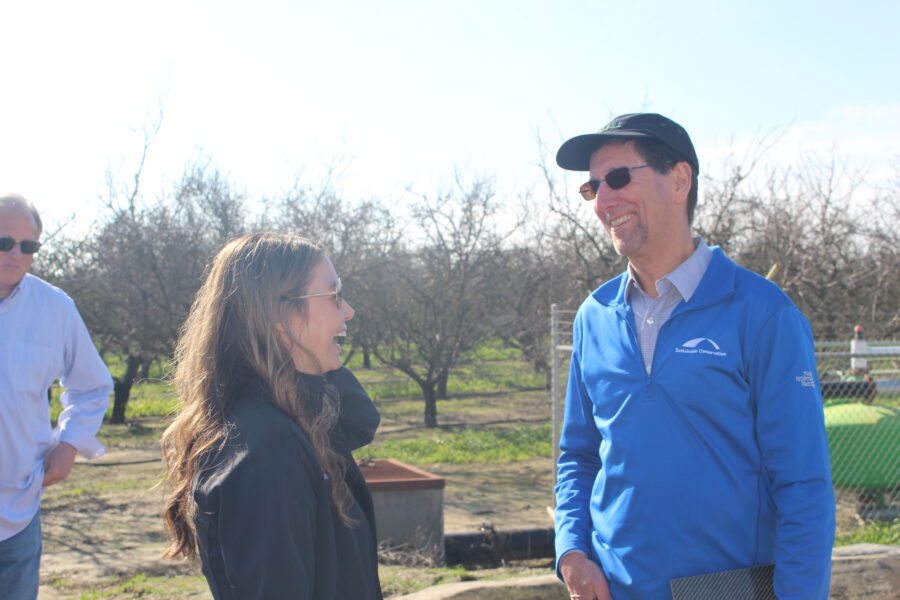
Michelle and Sustainable Conservation’s Daniel Mountjoy
In the broader California water landscape context, the insights shared by Michelle Reimers and Wes Miller shed light on the current challenges and innovations in water management. TID’s willingness to adapt to changing climate conditions and their proactive partnership with Sustainable Conservation to implement a groundwater recharge program showcases their forward-looking approach. Their emphasis on collaborative solutions and recognizing the intricate connection between agriculture and water sustainability underscores the urgency of comprehensive efforts to ensure California’s resilience in the face of ever-unpredictable climate change.
Check out the other conversations from A Watershed Moment Interview Series!
